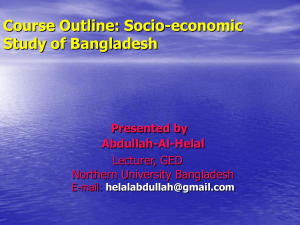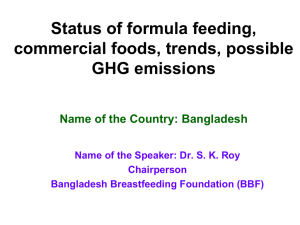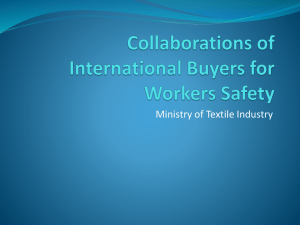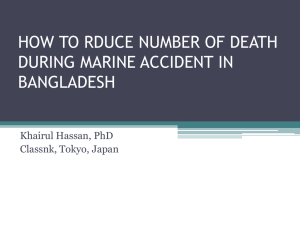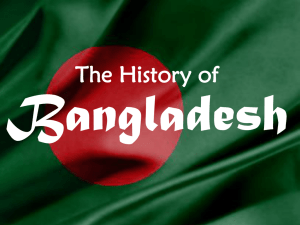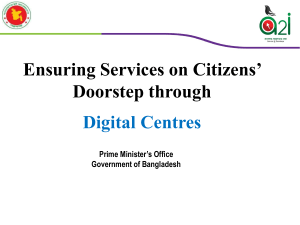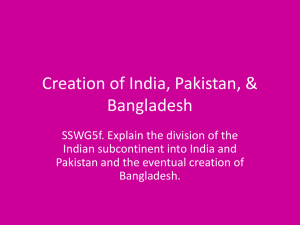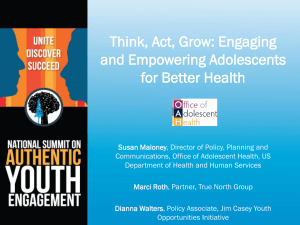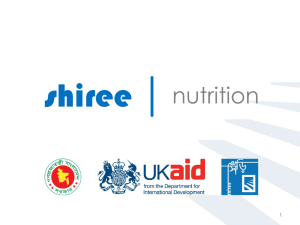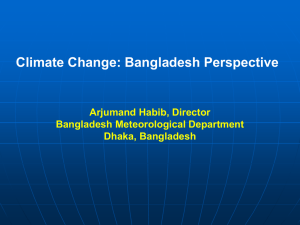Assessment of laws and policies for strengthening adolescent
advertisement
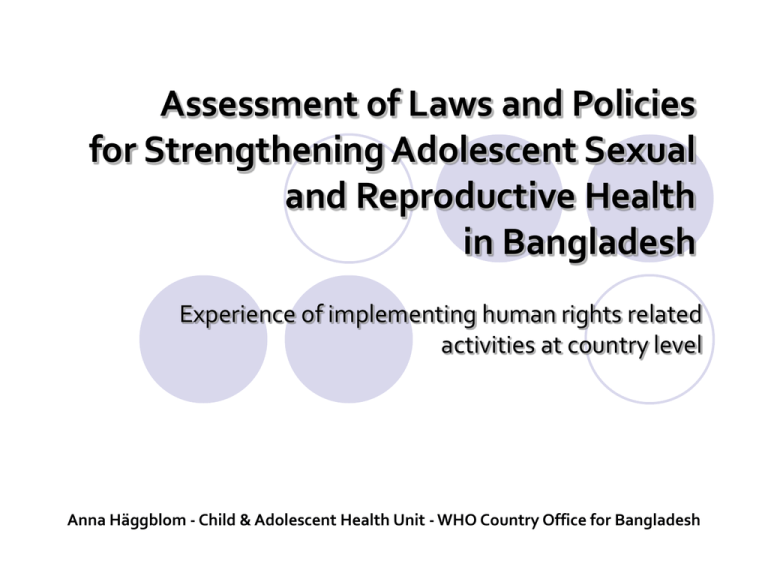
Assessment of Laws and Policies for Strengthening Adolescent Sexual and Reproductive Health in Bangladesh Experience of implementing human rights related activities at country level Anna Häggblom - Child & Adolescent Health Unit - WHO Country Office for Bangladesh HUMAN RIGHTS IN BANGLADESH “The Republic shall be a democracy in which fundamental human rights and freedom, and respect for the dignity and worth of the human person shall be guaranteed” Constitution of Bangladesh, article 11 All the international human rights treaties has been ratified (except CMV) Bangladesh has participated in almost all major international conferences related to human rights The right to life, food, health, shelter, basic necessities of life, speech, education are enshrined in the Bangladesh Constitution BANGLADESH CONTEXT Legal age of marriage: 18 years Mean age at first marriage: 15.7 years 18 14.9 years 16 14 Age 10-14 15-19 20-24 12 13 years 10 8 BDHS 93 BDHS 96 BDHS 99 BDHS 04 BDHS 07 Source: Bangladesh DHS 1993-2007 BANGLADESH CONTEXT (contd.) •Contraceptives are only provided to married adolescents through public facilities •Abortion is illegal, but menstrual regulation allowed (within 6-10 weeks) • Mean age at first birth: Age 30 25 18.7 18.4 1999-2000 2004 19 19 20 15 10 5 0 2007 Source: Bangladesh DHS 1999-2007 BANGLADESH CONTEXT (contd.) General fertility rate: 105 births/1000 women Adolescent specific fertility rate: 126 births/1000 women 200 196 192 180 188 192 173 160 ASFR/1000 140 140 147 144 135 120 126 10-14 100 15-19 80 20-24 60 40 20 0 4.6 BDHS 93 13.0 BDHS 96 9.8 4.8 BDHS 99 BDHS 04 BDHS 07 Source: Bangladesh DHS 1993-2007 Poor, non-educated, rural adolescents most vulnerable THE WHO GENERIC TOOL Developed by WHO HQ and Harvard School of Public Health Aim: improve awareness and understanding of States’ human rights obligations Method: systematic examination of the SRH status of vulnerable groups, involving non-health sectors, fostering civil society participation and developing recommendations to address regulatory and policy barriers to SRH with clear assignment of responsibility Goal: Strengthen the links between human rights and SRH, and contribute to national achievement of the highest attainable standard of health THE BANGLADESH PROCESS Entry point: adolescent pregnancy Advocacy efforts with Government of Bangladesh + other stakeholders Formation of Technical Advisory Group Formation of Core Group (respondents) Conduction of workshop for national adaptation of generic tool Objectives: 1. To examine the status and implications of human rights approach for adolescent health in Bangladesh 2. To study the national laws and policies related to core aspects of adolescents’ SRH 3. Review health data together with laws, policies and regulations related to adolescent SRH, in the context of human rights 4. Review and document government efforts to respect, protect and fulfill adolescents’ right in the context of SRH 5. Identify possible discrepancies in laws and policies that might be barriers to adolescent SRH THE BANGLADESH PROCESS (contd.) Data collection Workshop with policy makers and programme managers Interviews with legal and public health experts Document review Analysis using SWOT (Strengths, Weaknesses, Opportunities, Threats) framework Report writing Decision after feedback from HQ and regional level: further analysis needed CURRENT SITUATION Incomplete data on national laws and regulations Non-systematic analysis of health issues Unclear barriers and recommendations No clear linking with relevant human rights instruments Example of existing barriers: Inadequate protection of girls/women from early marriage Discrepancy between the Health Law/ Religious Law and the Criminal Code with regards to family planning information Inadequate legal provisions for unmarried adolescent women to access reproductive health services Inadequate provision of privacy, confidentiality and informed consent Senior legal expert and public health expert to work for 2 months to fill data gaps, more thoroughly conduct analysis identify barriers and formulate recommendations/suggestions CHALLENGES Culturally sensitive topics related to adolescent SRH Reluctance in GoB to discuss human rights Lack of knowledge? Fear of criticism? Difficult to talk about human rights “in isolation” Formulation of specific recommendations on how to overcome barriers without “pointing fingers” Finding persons with experience of both legal analysis and sexual and reproductive health Extensive tool Limited country capacity LESSONS LEARNT Sensitization and de-mystification needed on human rights and the added value for the field of health Government WHO staff National adaptation of tool crucial for: Understanding Ownership Future use of the report Countries need to find their own purpose for conducting the assessment: Bangladesh: door opener, stimulate dialogue, advocacy for AH Takes time…


